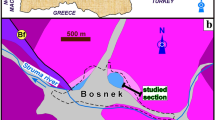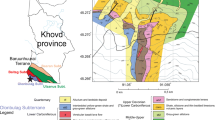Abstract
The travertines on which the ancient town of Paestum was built about 2,600 years ago, have been investigated to restore the original sedimentary environment of these freshwater limestones formed during the Late Pleistocene–Holocene in the southern sector of the Sele River plain. For this purpose, the few present outcrops of travertine have been analysed from a palaeoenvironmental point of view, integrating the morphology and the sedimentology of the substrate with the information on the textural patterns of the blocks forming the town walls, some of which have a clear similarity with the outcropping substrate. The Paestum travertines can be distinguished into two sedimentary units: the lower Paestum travertines (LPT) which formed between Late Pleistocene (75,000 years BP) and the Early Holocene, and the upper Paestum travertines (UPT) formed during Late Roman to Medieval times. The UPT reached various meters of thickness within the southern and western part of the town, obstructing completely its western entrance, Porta Marina, with its flanking side towers, and were largely removed during archaeological excavations that started in the 1930s. A possible mechanism for this fossilization calls for a process of progressive upward growth of an incrustation barrier within the door, while the calcariferous waters were flowing out from the town at increasing heights.





Similar content being viewed by others
Notes
The ancient town of Poseidonia was founded towards the end of the VII century B.P. by Greek colonists coming from Sibary. In 273 B.C. it became Roman taking the name of Paestum after a Lucanian domination (Paistom) from 400 B.C. The town was built on a travertine platform very near to the coastline of that time. The same material was used for the civil and sacred buildings. Initially, the region around Paestum was fertile and agreeable. However, almost at the beginning of the imperial times, as reported by Strabo, Paestum had become an unhealthy town because of the marshy environments formed all around it by the Salso river (today Capodifiume) whose lithifying properties were already well known at that time. The related bad drainage conditions further deteriorated between the VIII and IX centuries A.C. when Paestum was abandoned (D’Erasmo 1935). The hydraulic reclamation of the Sele plain is a very recent achievement.
The history of the excavations of Paestum starts in the eighteenth century and is linked to the construction of the road to Calabria by Charles III of Bourbon when first excavations allowed to bring to light its buried structures all around its temples, which became an attraction for foreign visitors such as Winkelmann and Goethe. After this first excavation, within the area of Paestum for a long time no further operation followed. Only at the beginning of the twentieth century (between 1907 and 1914), excavations involved the area between the Basilica and the Roman Forum. From 1925 to 1938 the excavation of the Forum and the temple of Ceres were completed. Finally, also the excavation of the walls was completed unearthing two of the fours doors, Porta Marina and Porta Giustizia. Starting from the end of the II world war, the area of Paestum is subject to systematic operations of excavation and restoration. In the 1950s, the areas around the Neptun and Ceres temples were interested by excavations that allowed the individuation and characterization of the urban areas. Between the end of the 60s and during the 70s the area of Paestum underwent systematic excavations that allowed to bring to light numerous and rich necropolis near and around the Paestum walls. Since then, the area within the walls and the peri-urban chora are subject to systematic excavations by Italian and international archaeological research teams.
References
Amato V, Avagliano G, Cinque A, Cipriani M, Di Paola G, Pontrandolfo A, Rosskopf MC, Santoriello A (2009) Geomorphology and geoarchaeology of the Paestum area: modifications of the physical environment in historical times. Mediterranée 112:129–135
Amato V, Aucelli PPC, Cinque A, D’Argenio Di, Donato V, Russo Ermolli E, Pappone G, Petrosino P, Rosskopf CM (2011) Holocene palaeo-geographical evolution of the Sele river coastal plain (Southern Italy): new morpho-sedimentary data from the Paestum area. Il Quaternario 24:5–7
Anzalone E (2008) Late Pleistocene travertines and their analogues under-deposition. A comparative analysis. Ital J Quat Sci 21(1B):91–98
Anzalone E, Ferreri V, Sprovieri M, D’Argenio B (2007) Travertines as hydrologic archives: the case of the Pontecagnano deposits (southern Italy). Adv Water Resour 30:2159–2175
Barra D, Calderoni F, Cinque A, De Vita A, Rosskopf C, Russo Ermolli E (1998) New stratigraphic data about the evolution of the Sele river coastal plain during Holocene. Il Quat 11(2):287–329
Barra D, Calderoni G, Cipriani M, De La Geniere’ J, Fiorillo L, Greco G, Mariotti Lippi M, Mori Secci M, Pescatore T, Russo B, Senatore MR, Tocco Sciarelli G, Thorez J et al (1999) Depositional history and palaeogeographic reconstruction of Sele coastal plain during Magna Grecia settlement of Hera Argiva (Southern Italy). Geol Romana 35:151–166
Brancaccio L, Cinque A, Russo F, Santangelo N, Allegri L, Alessio M, Improta S, Belluomini, G, Branca M, Delitala L (1988) Nuovi dati cronologici sui depositi marini della piana del Sele e della costa settentrionale del Cilento (Campania). Atti 74° Congresso Società Geologica Italiana A, pp 55–62
Brancaccio L, Cinque A, Belluomini G, Branca M, Delitala L (1986) Isoleucine epimerization dating and tectonic significance of upper Pleistocene sea level features of the Sele Plain (southern Italy). Z Geomorphol NF Suppl Bd 62:159–166
Buccino G, D’Argenio B, Ferreri V, Brancaccio L, Ferreri M, Panichi C, Stanzione D (1978) I travertini della bassa Valle del Tanagro (Campania): Studio geomorfologico, sedimentologico e geochimico. Boll Soc Geol Ital 97:617–646
Budillon F, Pescatore T, e Senatore MR (1994) Cicli deposizionali del Pleistocene superiore-Olocene sulla piattaforma continentale del Golfo di Salerno (Tirreno meridionale). Boll Soc Geol Ital 113:303–316
Celico P, De Gennaro M, Ferreri M, Ghiara MR, e Stazione D (1982) Geochimica delle sorgenti mineralizzate della Piana di Paestum (Campania, Italia). Periodico di Mineralogia 51:249–274
Cinque A, Romano P (a cura di) (2008) Note illustrative della Carta Geologica d’Italia alla scala 1:50.000 foglio 486 Foce del Sele. Parte I. ISPRA, Servizio Geologico d’Italia, p 83
Cipriani M, Pontrandolfo A (2010) Paestum: scavi, ricerche, restauri. Le mura. Il tratto da P. Sirena alla Postierla 47. Fondazione Paestum Tekmeria 8.1. Pandemos ed., p 408
D’Argenio B, Ferreri V (2004) Travertines as self regulating carbonate systems. Evolutionary trends and classification. Földtani Közlöny 1343(2):209–218
D’Argenio B, Ferreri V, Anzalone E (2008) The Paestum travertines. Lithology and depositional environments. Rendiconti online Società Geologica Italiana 2:1–2
D’Argenio B, Amato V, Anzalone E, Aucelli PPC, Cesarano M, Cinque A, Da Prato S, Di Paola G, Ferraro L, Pappone G, Petrosino P, Rosskopf CM, Russo Ermolli E Holocene palaeo-geographical evolution of the Sele river alluvial-coastal plain: new morphosedimentary data from Poseidonia-Paestum area (this volume)
D’Erasmo G (1935) Il bradisismo di Paestum. Ente per le Antichità e i Monumenti Provincia di Salerno, Pubb. N°1, p 32
Golubic S, Violante C, Ferreri V, D’Argenio B (1993) Algal control and early diagenesis in Quaternary travertine formation (Rocchetta a Volturno, Central Apennines). Boll Soc Geol Ital 1:231–247
Martin-Algarra A, Martin–Martin M, Andreo B, Julia R, Gomez C et al (2003) Sedimentary patterns in perched spring travertines near Granada (Spain) as indicators of the paleohydrological and paleoclimatological evolution of a karst massif. Sed Geol 161:217–228
Russo F, Belluomini G (1992) Affioramenti di depositi marini tirreniani sulla Piana in destra del Fiume Sele (Campania). Boll Soc Geol Ital 111:25–31
Acknowledgments
We would like to express our gratitude to the Institute for Coastal Marine Sciences of the National Research Council of Italy for the hospitality and support. We are also grateful to Patricia Sclafani for her help in the English translation and editing.
Author information
Authors and Affiliations
Corresponding author
Additional information
This paper is an outcome of the FISR project VECTOR (Vulnerability of the Italian coastal area and marine Ecosystems to Climate changes and their rOle in the Mediterranean caRbon cycles), sub-project VULCOST (VULnerability of COaSTal environments to climate changes) on: Land-sea interaction and coastal changes in the Sele River plain, Campania.
Rights and permissions
About this article
Cite this article
Amato, V., Anzalone, E., Aucelli, P.P.C. et al. Sedimentology and depositional history of the travertines outcropping in the Poseidonia-Paestum archaeological area. Rend. Fis. Acc. Lincei 23, 61–68 (2012). https://doi.org/10.1007/s12210-011-0155-z
Received:
Accepted:
Published:
Issue Date:
DOI: https://doi.org/10.1007/s12210-011-0155-z




